8 Ways Brands Are Using Messenger Apps to Reach their Audience
Messenger apps and their integrated chatbots are showing up more and more in our web faces and places.
Why?
To help answer questions, fulfill requests, and have other useful conversations with users—in real time.
Why dial a number, select an option on the keypad, then another… and another… to talk to a robot anyway? Frustrating.
It’s much easier for the user or customer to do this quickly online.
Brands get that.
Like 1-800-Flowers. They used online chat tools to generate 70 percent of their new customers.
Users get it, too. Nearly a quarter of the planet are expected to use messenger apps in 2019.
We’re following up our guide to using messenger bots for business with some real examples.
Hope these inspire you to surf the messenger app wave.
Bonus: Get a free social media strategy template to quickly and easily plan your own strategy. Also use it to track results and present the plan to your boss, teammates, and clients.
1. Stay top of mind
By sharing relevant content.
BuzzFeed does this well.
A leader in viral content, BuzzFeed uses WeChat to push personalized content to its subscribers.
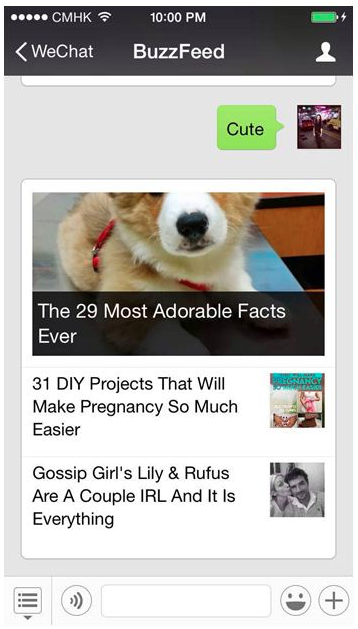
As a BuzzFeed subscriber on WeChat, you’ll receive a new piece of content every day.
And you can type in keywords like “fail,” “win,” and “cute,” over chat and a bot will respond with relevant content accordingly.
Takeaway: Show and share regularly, directly to your followers. It shows you care. How nice. And good for business.
2. Respond to customers instantly
Hard to do with a human. Easy to do with software.
Because… when a customer asks, you want to respond… pronto. Within the hour, even.
That’s what messenger apps are designed to do: deliver instant, one-on-one customer service.
The Kayak search engine does this.
Kayak uses Facebook Messenger as their customer support tool. To search flights, find travel deals, update itineraries, and receive trip recommendations.
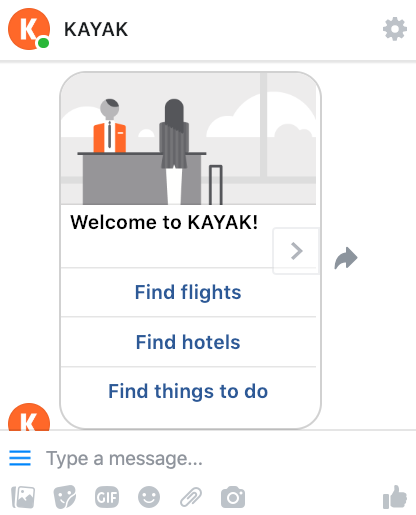
Just ask: “Can you suggest a hotel in Manhattan for New Years Eve?” Or, “Can you find me a romantic getaway for under $600?”
Kayak’s chatbot will filter thousands of search results to immediately answer your question. Then, pick what works best for you.
Takeaway: Your customers expect service right away, at all hours of the day and night. Give it to them with a chatbot.
3. Make it personal
Ask the right questions. Give the right answers.
H&M Clothing does.
They introduced their own Kik chatbot, which doubles as a personal stylist.
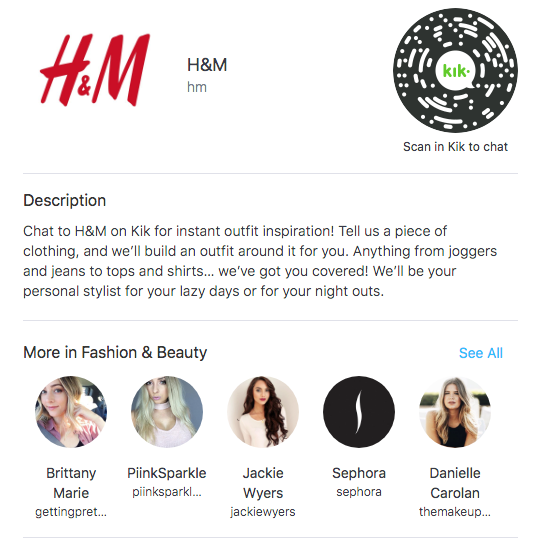
Want a new dress for the Royal Ball? Or a Mani suit to look more dashing than 007?
Talk to their chatbot. They’ll interrogate you first, with questions to zero in on your style.
This bot will show you a catalog of styles for the new you.
Move the items around or tap ‘share it’ or ‘save it’. Even better, tap ‘shop it’ to get a link to buy it online right there from your mobile app.
Sephora asks questions, too.
By becoming the first beauty retailer to use a messaging app for its shoppers, via the Kik chatbot.
Kik offers makeup tips, product recommendations, item reviews, video tutorials, and allows consumers to make purchases directly from the app.
Sephora likes millennials. Millennials like Kik. Kik’s got 300 million registered users, with 70 percent of them between age 13 and 25.
Nice match, huh?
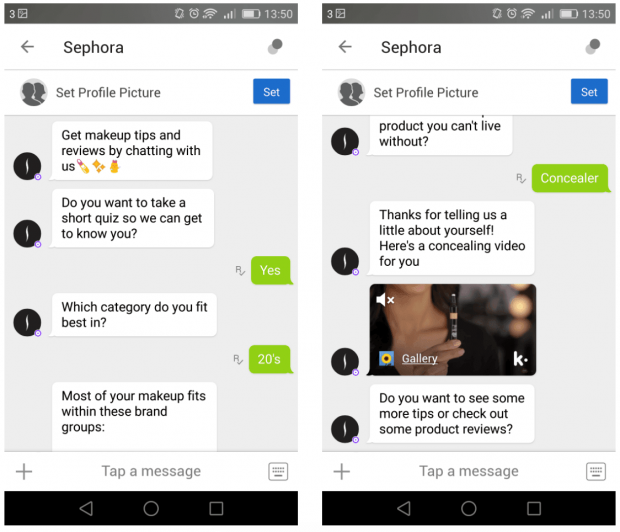
The Kik bot asks questions, too. Like age, favorite brands, and what your top go-to makeup item is. It’s a pretty nice way to gain user-specific insight while creating a great experience.
Takeaway: Use your bot to ask questions, gain insights, and help your customers make a purchase. Be as friendly online as in the store—while serving shoppers whenever and wherever.
4. Make shopping more fun
By entertaining users.
Whole Foods does this by making an everyday chore fun.
With Facebook Messenger, the grocery chain helps users find recipes for their next shopping trip.
Chat with a robot chef, select an ingredient emoji, then see recipes.
Imagine your shoppers able to mix and match emojis, along with keywords like ‘mediterranean’, ‘gluten-free’, or ‘vegetarian’. Users can go wild expressing flavors, cuisine, ingredients, and spices to make shopping fun, fast, and tasty.
Takeaway: Solve problems while entertaining shoppers for their weekly trip to your brick and mortar store. Might seem experimental now—but it won’t be later.
5. Know what customers want
By learning from your influencers like Adidas does.
They use private messaging apps Whatsapp, Line, and Facebook Messenger to share content, news, and products to ‘squads’ of local influencers.
But it’s not automated. Adidas in-house teams use the apps to talk directly with their influencers.
Squads are between 100 and 250 obsessed fans. Each of which has their own, sizable following on social media—just short of celebrity-status.
This allows Adidas to capture more thoughtful information and sensibilities from people who represent a larger base of customers and who are on top of fashion trends. Otherwise, releasing such info to the general public feels impersonal.
Takeaway: Use messenger apps internally to talk with influencers in your space one-on-one. They’ll feel more connected to your brand and represent you well on their own social channels. This way of communication is more personal than a blog or social network.
Bonus: Get a free social media strategy template to quickly and easily plan your own strategy. Also use it to track results and present the plan to your boss, teammates, and clients.
Get the free template now!6. Make buying easier
By doing some of the up-front work.
Burger King does.
They use the Facebook Messenger app to enable customers to order food before showing up at the door or window. They can also use it to find a nearby location and find out when their meal will be ready.
Same with Taco Bell and Domino’s.
Takeaway: Allow customers to operate on their own terms. With you doing the heavy work before they arrive, customers can simply show up, drive off, and enjoy the goods.
7. Promote your product in real-time
Because sometimes a lone image or 280 characters isn’t enough.
Taco Bell realized this.
So they launched their Spicy Chicken Cool Ranch Doritos Locos Tacos through Snapchat instead.
60 percent of Snapchat users are Gen Z.
Taco Bell timed its snaps with the MTV Movie Awards. Then, sent them throughout the day, creating a six-minute long film for users to view.
The product launch follows a film script on Snapchat where an overworked employee is demanded to find out what the new Doritos Locos Taco will be and bring it to his boss.
There’s romance, drama, comedy, and a cliffhanger.
Takeaway: For your next product launch… make it visual and create drama, with an exciting twist and plot. Maybe you, too, will get 74 million impressions and more than double your follower base.
8. Improve how people view your band
The Washington Post does.
Yes, a traditional news publication has been using chatbots since 2016.
See how they used Facebook Messenger for the last presidential election, when they reached 87 million users a month.
The purpose of the bot was to provide information to readers, to look like their typical posts.
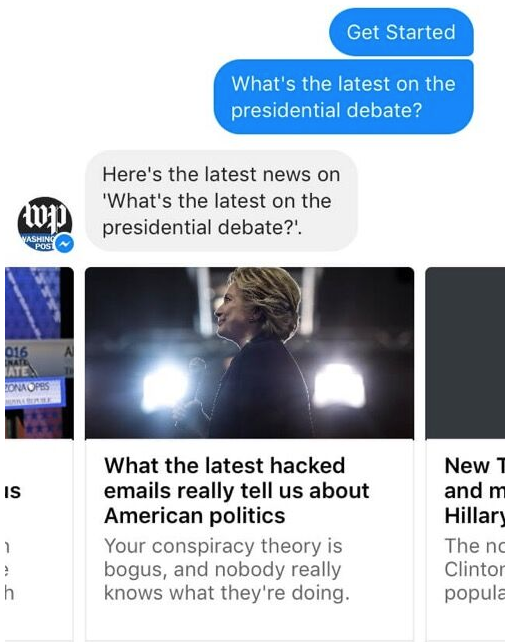
American users shared zip codes to get election results for their locations, through Associated Press polling data.
A quick way to retrieve information on a plethora of issues, for journalists and subscribers.
Takeaway: Sharpen your brand perception among readers. Experiment with an automated bot to share valuable content.
Get started with your own messenger app strategy today.
Connect with your audience on social media using Hootsuite. Easily manage all your social channels and engage followers across networks from a single dashboard. Try it free today.
The post 8 Ways Brands Are Using Messenger Apps to Reach their Audience appeared first on Hootsuite Social Media Management.
Categories
- 60% of the time… (1)
- A/B Testing (2)
- Ad placements (3)
- adops (4)
- adops vs sales (5)
- AdParlor 101 (43)
- adx (1)
- algorithm (1)
- Analysis (9)
- Apple (1)
- Audience (1)
- Augmented Reality (1)
- authenticity (1)
- Automation (1)
- Back to School (1)
- best practices (2)
- brand voice (1)
- branding (1)
- Build a Blog Community (12)
- Case Study (3)
- celebrate women (1)
- certification (1)
- Collections (1)
- Community (1)
- Conference News (1)
- conferences (1)
- content (1)
- content curation (1)
- content marketing (1)
- contests (1)
- Conversion Lift Test (1)
- Conversion testing (1)
- cost control (2)
- Creative (6)
- crisis (1)
- Curation (1)
- Custom Audience Targeting (4)
- Digital Advertising (2)
- Digital Marketing (6)
- DPA (1)
- Dynamic Ad Creative (1)
- dynamic product ads (1)
- E-Commerce (1)
- eCommerce (2)
- Ecosystem (1)
- email marketing (3)
- employee advocacy program (1)
- employee advocates (1)
- engineers (1)
- event marketing (1)
- event marketing strategy (1)
- events (1)
- Experiments (21)
- F8 (2)
- Facebook (64)
- Facebook Ad Split Testing (1)
- facebook ads (18)
- Facebook Ads How To (1)
- Facebook Advertising (30)
- Facebook Audience Network (1)
- Facebook Creative Platform Partners (1)
- facebook marketing (1)
- Facebook Marketing Partners (2)
- Facebook Optimizations (1)
- Facebook Posts (1)
- facebook stories (1)
- Facebook Updates (2)
- Facebook Video Ads (1)
- Facebook Watch (1)
- fbf (11)
- first impression takeover (5)
- fito (5)
- Fluent (1)
- Get Started With Wix Blog (1)
- Google (9)
- Google Ad Products (5)
- Google Analytics (1)
- Guest Post (1)
- Guides (32)
- Halloween (1)
- holiday marketing (1)
- Holiday Season Advertising (7)
- Holiday Shopping Season (4)
- Holiday Video Ads (1)
- holidays (4)
- Hootsuite How-To (3)
- Hootsuite Life (1)
- how to (5)
- How to get Instagram followers (1)
- How to get more Instagram followers (1)
- i don't understand a single thing he is or has been saying (1)
- if you need any proof that we're all just making it up (2)
- Incrementality (1)
- influencer marketing (1)
- Infographic (1)
- Instagram (39)
- Instagram Ads (11)
- Instagram advertising (8)
- Instagram best practices (1)
- Instagram followers (1)
- Instagram Partner (1)
- Instagram Stories (2)
- Instagram tips (1)
- Instagram Video Ads (2)
- invite (1)
- Landing Page (1)
- link shorteners (1)
- LinkedIn (22)
- LinkedIn Ads (2)
- LinkedIn Advertising (2)
- LinkedIn Stats (1)
- LinkedIn Targeting (5)
- Linkedin Usage (1)
- List (1)
- listening (2)
- Lists (3)
- Livestreaming (1)
- look no further than the new yorker store (2)
- lunch (1)
- Mac (1)
- macOS (1)
- Marketing to Millennials (2)
- mental health (1)
- metaverse (1)
- Mobile App Marketing (3)
- Monetizing Pinterest (2)
- Monetizing Social Media (2)
- Monthly Updates (10)
- Mothers Day (1)
- movies for social media managers (1)
- new releases (11)
- News (72)
- News & Events (13)
- no one knows what they're doing (2)
- OnlineShopping (2)
- or ari paparo (1)
- owly shortener (1)
- Paid Media (2)
- People-Based Marketing (3)
- performance marketing (5)
- Pinterest (34)
- Pinterest Ads (11)
- Pinterest Advertising (8)
- Pinterest how to (1)
- Pinterest Tag helper (5)
- Pinterest Targeting (6)
- platform health (1)
- Platform Updates (8)
- Press Release (2)
- product catalog (1)
- Productivity (10)
- Programmatic (3)
- quick work (1)
- Reddit (3)
- Reporting (1)
- Resources (34)
- ROI (1)
- rules (1)
- Seamless shopping (1)
- share of voice (1)
- Shoppable ads (4)
- Skills (28)
- SMB (1)
- SnapChat (28)
- SnapChat Ads (8)
- SnapChat Advertising (5)
- Social (169)
- social ads (1)
- Social Advertising (14)
- social customer service (1)
- Social Fresh Tips (1)
- Social Media (5)
- social media automation (1)
- social media content calendar (1)
- social media for events (1)
- social media management (2)
- Social Media Marketing (49)
- social media monitoring (1)
- Social Media News (4)
- social media statistics (1)
- social media tracking in google analytics (1)
- social media tutorial (2)
- Social Toolkit Podcast (1)
- Social Video (5)
- stories (1)
- Strategy (608)
- terms (1)
- Testing (2)
- there are times ive found myself talking to ari and even though none of the words he is using are new to me (1)
- they've done studies (1)
- this is also true of anytime i have to talk to developers (1)
- tiktok (8)
- tools (1)
- Topics & Trends (3)
- Trend (12)
- Twitter (15)
- Twitter Ads (5)
- Twitter Advertising (4)
- Uncategorised (9)
- Uncategorized (13)
- url shortener (1)
- url shorteners (1)
- vendor (2)
- video (10)
- Video Ads (7)
- Video Advertising (8)
- virtual conference (1)
- we're all just throwing mountains of shit at the wall and hoping the parts that stick don't smell too bad (2)
- web3 (1)
- where you can buy a baby onesie of a dog asking god for his testicles on it (2)
- yes i understand VAST and VPAID (1)
- yes that's the extent of the things i understand (1)
- YouTube (13)
- YouTube Ads (4)
- YouTube Advertising (9)
- YouTube Video Advertising (5)

